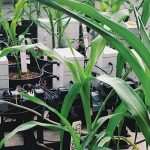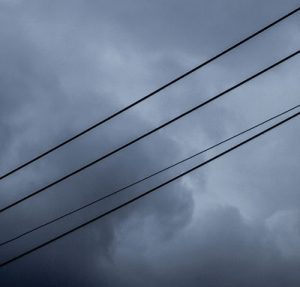Mail-in, fast-scan tests for COVID-19
No long line, no medical staff in full protective gear, no waiting. Nigel Reuel is leading development of an at-home, closed, contact-free diagnostic sensing system that could be used to quickly test for COVID-19 or other outbreaks.
Reuel’s team envisions a low-cost, mail-safe, fast-scan platform built around his closed sensing systems that use paper-based resonant sensors. Also key to the approach is a “toehold switch” that detects target RNA genetic material, triggering production of “reporter” proteins that change the frequency of the sensor’s signal.
The finished product will likely involve a multilayered assembly on thick paper. The top layer would hold collected samples, middle layers would contain the toehold switch and bottom layers a printed, coiled resonant circuit.
Testing would be as easy as taking your own sample, putting in an envelope and dropping it in the mailbox or collection center. Electronic readers then scan the sensor in the never-opened envelope and automatically text, email and record results.
Reuel said his idea would address several urgent testing problems: “This approach off-loads the burden of diagnostics from health workers, eliminates the increased use of limited personal protective equipment, and provides a better response to outbreaks.”
Data-based face coverings
When the problem of mask shortages emerged during COVID-19, Cyclone Engineers turned to the core engineering principle of data-driven problem solving to help out.
An interdisciplinary team of researchers with expertise in materials science and engineering, industrial and manufacturing systems engineering, and textiles and clothing studied the best methods to make protective face masks using 3-D printing. The team examined multi-layer design, functional requirements, sterilization methods, and stiffness and strength of gaskets to determine how to make cost-effective masks that adhere to regulations and best protect the people wearing them.
The team’s preliminary research suggests a first layer of a 3-D printed gasket, a second layer of waterproof nonwoven fabrics, and the third layer of nonwoven fabrics similar to a paper towel.
The team initially planned to create masks for medical personnel, but as the shortage of medical-grade masks eased – and the need for non-medical grade masks grew – the team has shifted its focus to developing recommendations for masks for everyday use.
Leading the Way Online
When the COVID-19 pandemic made it a necessity to shift all coursework online at Iowa State University, Amy Kaleita already had a library of resources at her fingertips and a wealth of experience to help her colleagues make the transition.
Kaleita got her start with teaching courses online in 2007 when she went on maternity leave in the middle of a semester. She filmed a series of lectures ahead of time, which were combined with question-and-answer sessions and other hands-on course materials during her leave.
Her early introduction to online instruction meant she was more than up to the task when moving online this spring. But Kaleita knew her tried-and-true resources and best practices might be useful to others who were shifting quickly to remote instruction. So she helped to quickly orchestrate a workshop with other faculty in her department to prepare.
“In the early days, things were changing so fast, but since Iowa State had already embraced a wide range of online learning opportunities for students, we had a good foundation. We could all look at each other and say ‘we can do this’ – and we did it.”
Mini brains on a chip
Long Que, associate professor of electrical and computer engineering, David Jiles, Anson Marston Distinguished Professor of Engineering, and Donald Sakaguchi, Morrill Professor and expert in neuroscience, are creating synthesis technique to make “mini brains” on a chip, to make possible new studies on transcranial magnetic stimulation and drug treatment in neurodegenerative disorders. The team is developing a chip-based microfluidics platform for rapid formation of 3D in vitro culture models of the nervous system.
Wiping away microbes
Sonal Padalkar, assistant professor of mechanical engineering, develops electrochemical deposition techniques to grow metal-oxide nanomaterials on cheap, lightweight, flexible cloth and paper. The zinc oxide, cerium oxide and copper oxide nanoparticles on the fabric or paper puncture the cell walls of bacteria, making for an effective, chemical-free disinfecting wipe.

 Fitbit for plants
Fitbit for plants
Liang Dong, professor of electrical and computer engineering, is developing a Fitbit-like tracker that will monitor crop fields at almost single-plant resolution. Combining these wearable plant sensors with soil and water sensors, Dong and his interdisciplinary research team will create a cyber-physical system to help farmers precisely manage water and fertilizer use and increase crop productivity.
More than sum of its parts
Matt Frank, John B. Slater Professor in Sustainable Design & Manufacturing, collaborates with John Deere to advance hybrid manufacturing techniques. Frank works with teams at John Deere’s Ames Technology Innovation Center in Iowa State’s Research Park and at other locations to combine computer numerical controlled machining with additive manufacturing, like 3D printing.
“Combining the strengths and diminishing the weaknesses of the two systems is a real force multiplier, making it possible to reduce cost and lead time in delivery prototypes and production solutions,” said Frank.
 Steady lines in a storm
Steady lines in a storm
Partha Sarkar, professor of aerospace engineering, is predicting how and why power transmission and bridge support cables “gallop” in high winds, causing outages and structure damage. Using five years of wind tunnel experiments on cable vibrations in high winds, Sarkar’s team is now creating a wind-load model and methodology that can be used to identify vulnerability to cable galloping – and enable engineers to find solutions to dampen runaway cables.